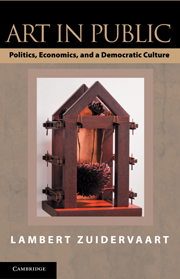4 - Public Sphere
Published online by Cambridge University Press: 05 June 2012
Summary
Any public [that] denies artistry its rightful place under the sun forfeits a rich source of imaginative knowledge.
Calvin SeerveldPart I showed why public debates between advocates and opponents of government arts funding so frequently misfire. These debates ignore both the internal complexity of a three-sector economy and the role of the state in the societal constitution of art. They misconstrue the sociocultural character and the public orientation of contemporary art. And they fail to recognize the sociocultural and sociopolitical reasons why the arts are societally important. I have also criticized mainstream justifications of government arts funding and pointed to both an economic and a political dialectic among capitalism, the state, and civil society. To lay groundwork for an alternative case, I introduced two concepts that need further elaboration: civic sector and public sphere. Completing this groundwork, the next three chapters provide a more detailed account of the roles of art in civil society and the dialectical tensions they involve.
Three events in 1989, at the height of North American controversies about government arts funding, mark a new phase in the development of theories about civil society and the public sphere: the $14 billion merger of Time and Warner Communications; the fall of the Berlin Wall; and the publication in English of Jürgen Habermas’s book on the public sphere. Whereas the creation of Time Warner Inc. confirmed the increasingly global and hypercommercialized character of many cultural media, the reunification of Germany signaled new opportunities for democratic discourse in Eastern European countries where the state had long controlled such media. Appearing at this juncture, Habermas’s book immediately entered a growing debate over prospects for the public sphere. The outbreak of old ethnic hostilities in Eastern Europe and the continuation of new culture wars in the West increased the debate’s significance.
Information
- Type
- Chapter
- Information
- Art in PublicPolitics, Economics, and a Democratic Culture, pp. 91 - 128Publisher: Cambridge University PressPrint publication year: 2010
